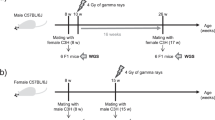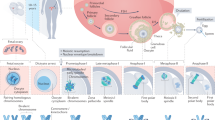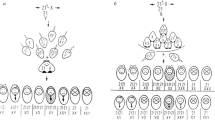Abstract
ANEUPLOIDY can result either from non-disjunction, giving trisomy and monosomy, or from chromosome damage leading to loss of chromosomes (monosomy) only. It is known that chromosome loss can be induced after irradiating post-meiotic male germ cells1, but apart from findings on radiation-induced non-disjunction in oocytes from mice2–5, there is no evidence that paternal exposure to X rays induces chromosomal mal-segregation during male meiosis to produce monosomic and trisomic offspring. Szemere and Chandley6 did observe significantly more mal-segregated X and Y chromosomes in spermatocytes II after 100 and 200 rad had been given during preleptotene and pachytene, but failed to recover aneuploid fetuses in progeny from irradiated males. They suggested that only a few aneuploid spermatocytes would be transmitted to the next generation. We have now shown that such induced aneuploidy is indeed transmitted and can be detected in a monosomic and trisomic condition in F1 fetuses on day 9.5 of gestation.
This is a preview of subscription content, access via your institution
Access options
Subscribe to this journal
Receive 51 print issues and online access
$199.00 per year
only $3.90 per issue
Buy this article
- Purchase on Springer Link
- Instant access to full article PDF
Prices may be subject to local taxes which are calculated during checkout
Similar content being viewed by others
References
Russell, L. B. & Saylors, C. L. Repair from Genetic Radiation Damage (ed. Sobels, F. H.) 313 (Pergamon, Oxford, 1953).
Uchida, I. A. & Lee, C. P. V. Nature 250, 601–602 (1974).
Uchida, I. A. & Freemann, C. P. V. Nature 265, 186–187 (1977).
Reichert, W., Hansmann, I. & Röhrborn, G. Hum. Genet. 28, 25–38 (1975).
Yamamoto, M., Shimada, T., Endo, A. & Watanabe, G. Nature new Biol. 244, 206–208 (1973).
Szemere, G. & Chandley, A. C. Mutat. Res. 33, 229–238 (1975).
Evans, E. P., Burtenshaw, M. D. & Ford, C. E. Stain Technol. 47, 229–234 (1972).
Hansmann, I. & El-Nahass, E. Cytogenet. Cell Genet. (in the press).
Gropp, A. (ed.) Ciba Fdn Symp. 40 (1976).
Langenbeck, U., Hansmann, I., Hinney, B. & Hönig, V. Hum. Genet. 33, 89–102 (1976).
Jacobs, P. A. & Morton, N. M. Hum. Hered. 27, 59–72 (1977).
Lazar, P., Guegüen, S. & Boué, A. Les Accidents Chromosomiques de la Réproduction (eds Boué, A & Thibault, C.) 317 (INSERM, Paris, 1973).
Author information
Authors and Affiliations
Rights and permissions
About this article
Cite this article
HANSMANN, I., ZMARSLY, R., PROBECK, H. et al. Aneuploidy in mouse fetuses after paternal exposure to X rays. Nature 280, 228–229 (1979). https://doi.org/10.1038/280228a0
Received:
Accepted:
Published:
Issue Date:
DOI: https://doi.org/10.1038/280228a0
This article is cited by
-
Risk calculations for hereditary effects of ionizing radiation in humans
Human Genetics (1992)
-
Nondisjunction and chromosome breakage in mouse oocytes after various X-ray doses
Human Genetics (1982)
-
Methods for analysis of the mutagenicity of indirect mutagens/carcinogens in eukaryotic cells
Human Genetics (1980)
Comments
By submitting a comment you agree to abide by our Terms and Community Guidelines. If you find something abusive or that does not comply with our terms or guidelines please flag it as inappropriate.



